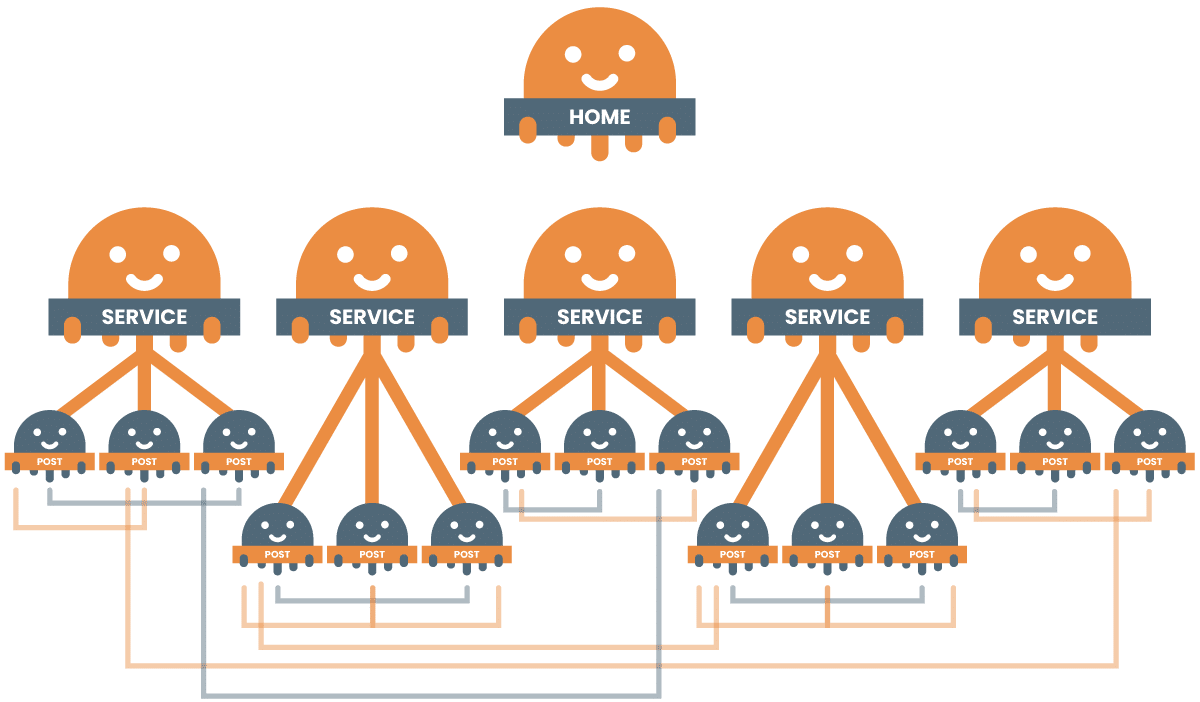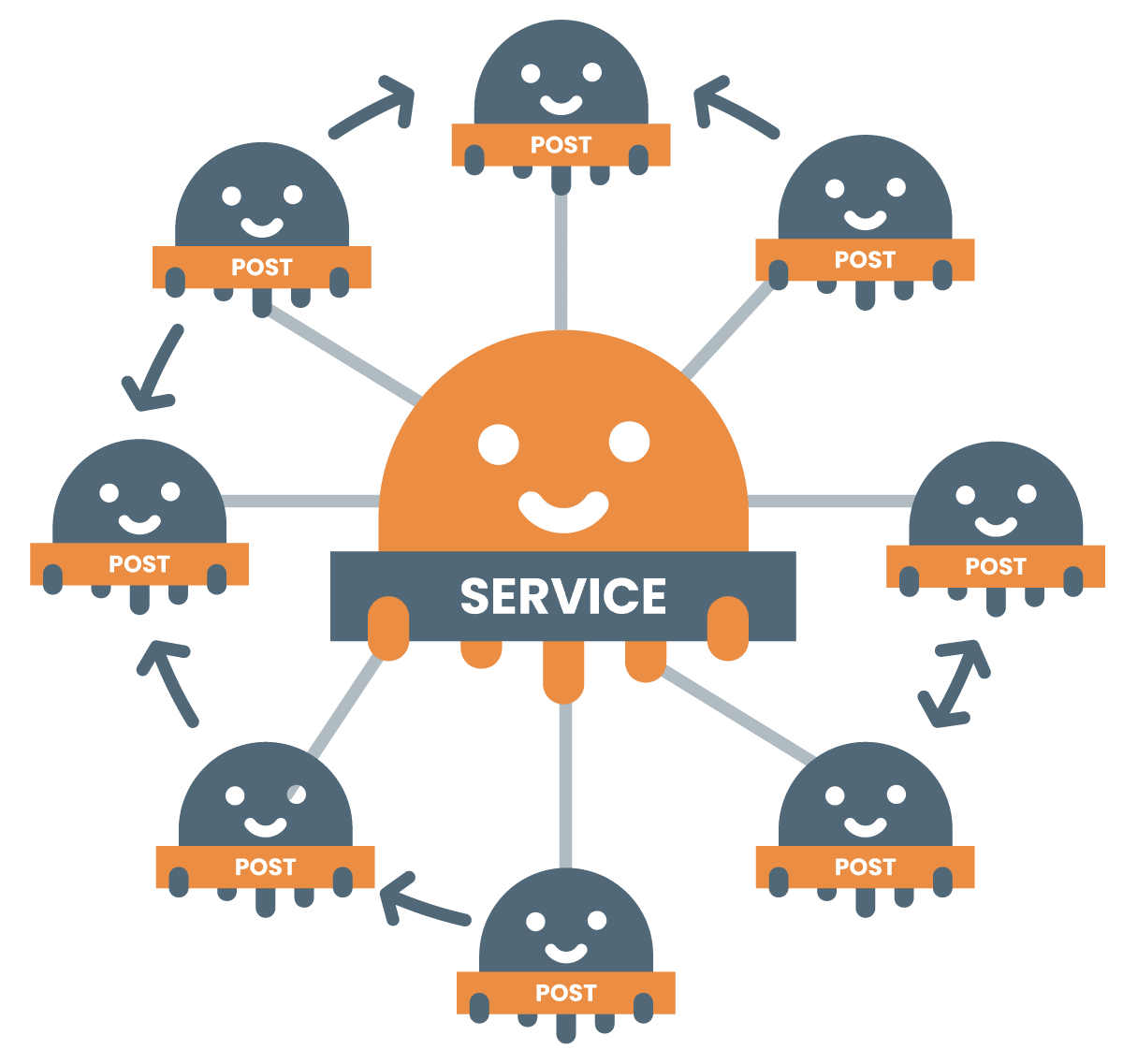
Internal linking is probably one of the most overlooked aspects of SEO, but done well, it can have a significant impact.
If you are even remotely concerned with the on-page SEO of your website, you will already know about internal links, but you may not know that there is far more to it than simply adding a few internal links around your site.
Contents
- What is internal linking?
- An explanation of the terminology
- A note on anchor text context
- Why is internal linking important?
- Why you need a strategy and SOP
- An example strategy
- An example SOP
- Finding internal links
- Golden rules of internal linking
- The easiest way to improve internal linking
What is internal linking?
For anyone that does not already know, it’s the process of linking one of the pages of your website or posts to another of the pages or posts of your website.
The purpose of these links is to provide contextual navigation across your site so visitors can find related content that may interest them.
It also helps the Search Engine bots to navigate your website and understand the context of your site and its content.
Here’s a great explanation about Internal Links from ahrefs.
An explanation of the terminology.
There are many words and phrases that we use a lot regarding internal link building, so to help anyone who is learning about this, here are the explanations:
- Context: The relevancy of the anchor text to the page it is linking to.
- Anchor text: The text used for the link on the page. Using descriptive anchor text that accurately reflects the page content you are linking to is essential.
- Internal link: A link that connects one page on a website to another page on the same website.
- Link equity: The value passed through a link from one page to another. Link equity can help improve the ranking of the linked pages. This is often also referred to as Link Juice.
- PageRank: A measure of the importance of a page on a website, as determined by Google. PageRank is calculated based on the number and quality of links pointing to a page.
- Related pages: Pages that are closely related in content or topic. Linking to related pages can help improve your website’s navigation and the relevance of your content.
- Spam links: Links placed on a page to increase the PageRank of the page. Spam links can hurt the reputation of your website and your rankings.
- Weighted link: A link that is given more importance than other links. Weighted links can be used to prioritize certain pages on your website.
- Bots: Search Engine programmes that index your website.
- SERPs: Acronym for ‘Search Engine Results Pages’.
Note the word: Context.
One of the main reasons that internal link building takes time is that the internal links you add to your site must make sense from a contextual perspective.
So, for example, if you have a landing page on your site about Motorcycle repairs and link to it from a blog about Car Servicing, this is not a contextually correct internal link and only confuses everyone.
- If you confuse a visitor, they’ll bounce
- If you confuse a Search Engine, it will result in lower rankings
If you want to ensure your Motorcycle Repairs page is linked correctly, only link to it from other content about Motorcycles using anchor texts relevant to Motorcycles (that’s internal linking in a nutshell).
Why is internal linking important?
Visitors and bots will have difficulty making sense of your site if you don’t internally link any of your content. It’s that simple.
If visitors and bots don’t understand your site, they will not use or index it, and you will not rank in the SERPs for anything other than a few random keywords.
Other aspects of why internal linking is essential are PageRank and new content.
Internal links distribute PageRank across your site and help to get your important pages ranking in the search.
Generally, content with more internal links is seen as more important in your internal page ranking and therefore seen as more important by Search bots.
When you post new content, you can also promote this on your site by adding new internal links from existing content to help get it found.
This is already getting complicated.
We’ve only just started talking about this, and you can see that even the basics of internal linking can get complicated.
This is often one of the main reasons why internal link-building is done as an afterthought.
Don’t just read half this post and dive into your site, all that will happen is that you’ll end up with a messy internal link profile.
You need an internal linking strategy and SOP.
Prevention is better than cure when it comes to internal linking, so having a plan before diving into your site is always the best policy.
What does an internal link strategy look like?
It does not have to be complex; it just needs consistency.
Look at your website’s current content and structure and use that to plan where you might use internal links, and write an SOP (standard operating procedure) to ensure you follow the process each time you write new content.
First, let’s take a look at site structure and the difference between architectural and contextual links.
A typical architectural link map.

A content cluster.

These are the two ways you will probably plan out the content on your site.
And the example strategy:
If you have a large WordPress site, you’ve probably already got some form of strategy for your site regarding content and architecture.
It might look something like this:
- Homepage
- Top-level landing page (services, for example)
- Posts around each top-level landing page
- Categories and Tags for posts
So we already know that we don’t want to force our homepage to rank for anything – we’ll let Google rank that based on the site content, so the pages to start with are the landing pages.
These will be architecturally linked from your main navigation as they are important.
You’ve probably already written blogs around your services and hopefully contextually linked these back to your service landing pages.
You should also have contextually cross-linked (not reciprocally, unless there is a really good match for the pages) across these blogs.
To summarise:
- Your important landing pages are linked to from your main navigation
- Your blogs link to your landing pages
- Each blog cross-links to other blogs
If you’ve already got a structured link like this, high-fives all-round. If you haven’t, you need to complete this as the first page of your strategy.
Here’s an example SOP for publishing new content.
An SOP lists the procedure for publishing new content. It will depend a lot on your service or niche, but it might be something like this:
- When we publish new content, it must have the following:
- One external link
- One internal contextual link to a landing page
- One internal contextual link to another post
- At least one image in the content
- A video, if possible
- A contents section, if the content requires it
- Author Details
- One category
- Maximum of two tags (can get messy if there is more than one)
- A call-to-action
- It needs to be at least 800 words
- It must use headings and crossheads
Most of this list will affect your on-page SEO, so it must all be considered.
With so many other on-page factors, it’s easy to see why some content just gets quickly linked to something that ‘will do’ rather than considering the effect on the whole SEO of the site.
Knowing you need to add internal links is one thing; finding the right ones is something else.
When adding internal links to content, we need to consider the following:
- Use relevant and contextual links. When you add internal links, make sure they are relevant to the content on the page where they are placed. This will help users understand why you are linking to another page and make it more likely that they will click on the link.
- Use descriptive anchor text. The anchor text is the text that appears when you hover over a link. It is important to use descriptive anchor text that accurately reflects the content of the page you are linking to. This will help users understand what the link is about and make it more likely that they will click on it.
- Avoid over-linking. Too many internal links can be overwhelming for users and make it difficult to scan a page. Aim to use a few internal links per page and make sure they are spaced out evenly.
- Use a variety of link types. You can use a variety of link types in your internal linking strategy, such as text links, image links, and anchor links. Experiment with different types of links to see what works best for your website.
- Use a link checker tool. There are a number of link checker tools available that can help you identify broken links on your website. This is important to do regularly to ensure that your internal linking is working properly.
That’s a lot for each link.
The problems you face with internal linking and the above consideration are as follows:
- You must have an inherent knowledge of all the site content to be able to use relevant contextual links.
- You’ve got the have the same inherent knowledge to be able to use descriptive anchor text.
- To avoid over-linking, you’ve got to be able to check the links on the current and any potential target link page.
- To be able to use a variety of link types and anchor texts, you have to know what all the other internal link types and anchor texts are on the whole site.
- You can use a link checker tool, but seeing context is not something they often do well, and context is everything in internal linking.
To get the best internal linking structure, you need an internal linking tool that gives you as much data as possible to link effectively.
WILO gives you contextual and meaningful data about your current internal links so you can add new ones to benefit your SEO. Try the internal linking tool for free.
The other golden rules for internal linking.
Link to your most important pages.
Internal linking boosts the PageRank of your pages, so always link to the content that you want to see ranking in the search results.
Link to related pages.
If an internal link is contextually confusing, it will harm your site.
Link to new pages.
When you publish new content on your site, you need to get links from older content to help bots and visitors find it.
Avoid spammy activity.
Don’t link internally or externally to spammy, low-value pages; they won’t do you any good.
The easiest way to improve your internal linking.
WILO is a tool that is built solely for internal linking.
Unlike other kitchen sink tools like Yoast and Link Whsiperer, WILO only does internal links, so you can add the plugin to your site even if you already use another SEO plugin, as it adds additional benefits to these other, already great SEO tools.
Whether for your site or if you work in SEO and have just inherited a large WordPress site, WILO helps you see all your internal linking and empowers you to improve or fix it.
The free plugin works on the front end of your website, so you can easily see the following:
- How many internal links the current page has
- The anchor texts of those links
- The number of duplicate links
- The number of duplicate anchor texts
- The link juice being passed (as a percentage)
- The context of the link, not just the anchor text
- If linking pages have too many links
- If there is a reciprocal link
Install our free internal link tool today and start improving your internal links!





